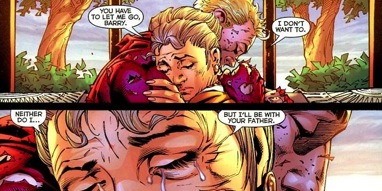Flashpoint is most often spoken about as the event series that ushered in the New 52, DC’s line-wide reboot of their universe. Beyond that, it was one of the most divisive storylines while being published, as it debuted an DC universe unlike anything the readers were familiar with: Wonder Woman and Aquaman are at war, Thomas Wayne is Batman, and… well, everything is pretty messed up. Beyond that, I’ve seen it cited as a major example of why readers have event fatigue. Flashpoint’s central miniseries was a short and sweet five issues, but the event itself included a whopping 61-issues if you count the crossovers, miniseries, and one-shots. But you know what Flashpoint very rarely gets credit for?
It’s a perfect comic book.
Now, let’s dial back. I’m not talking about the whole event – I only read the main series, which stands completely alone. I appreciate that it introduced an interested enough world, in theory, to spawn so many off-shoots, but when I read Flashpoint, my DC pull list was minimal. I think I was only reading Detective Comics, Supergirl, and Superman. I picked up Flashpoint not because of the ramifications it would have, but because I thought it would be a fun and intense superhero epic. It was exactly that, but it’s what I didn’t expect it to be that makes this series such an extraordinary example of how great comic books can be.
We’ll get to that in a bit.
When Flashpoint came around, Geoff Johns had just begun a new Flash run that put Barry Allen back as the Scarlet Speedster. He’d given it the Rebirth treatment that he’d bestowed upon Green Lantern seven years prior and would give the entire DC Universe five years later. Here, in Flashpoint, Johns’ puts us firmly in Barry’s shoes, allowing us to see this altered DC Universe through his point of view, which offers a level of focus that is pretty rare in an event series. Johns’ writing is at its best here, giving us a Barry Allen that we can emotionally invest in while also dropping enough splashes, double-page spreads, and action sequences to get the goods from an art team like Andy Kubert on pencils, Sandra Hope on inks, and Alex Sinclair on colors. But every bit as visually astounding as the comic is, it’s the character motivation – the heart of Flashpoint – that took me by surprise.
Barry Allen went back in time to save his mother. That is the moment that creates this Flashpoint universe, and his tragic reversal of that decision is what then ushers in the New 52 universe.
Think about that for a second. DC’s entire line was revamped not because of some cataclysmic cosmic event, not a dimensional shift, not a superhero fight so massive that it shook reality. No, the entire world was changed because the Flash missed his mother. That reveal was enormously moving to me then, and sticks with me to this day, because as fun as it is to watch superheroes thrown down with a cool bad guy, and as inspiring as these heroes are to so many people both young and old, the reason that characters like the Flash and Batman and Wonder Woman matter is because beyond their cool costumes, gadgets, rogue galleries, and powers, we see something of ourselves in them.
And if they can be heroes, with all of their flaws and with all of their pain, maybe we can be too.
PAT SHAND writes comics (Van Helsing, Vampire Emmy, Disney Princess), novels (Iron Man, Charmed), and pop culture journalism (Sad Girls Guide, Blastoff Comics). You can find him at Heroes Con this June, where he will debut his latest creator-owned comic, Vampire Emmy and the Garbage Girl. If you come by his booth to get a copy, be prepared to be bombarded with the latest cell phone pictures of his cats.




Comments are closed.